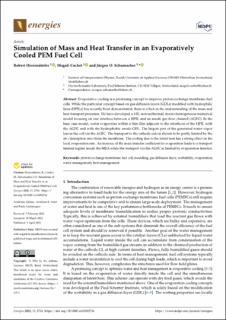Please use this identifier to cite or link to this item:
https://doi.org/10.21256/zhaw-25029Full metadata record
| DC Field | Value | Language |
|---|---|---|
| dc.contributor.author | Herrendörfer, Robert | - |
| dc.contributor.author | Cochet, Magali | - |
| dc.contributor.author | Schumacher, Jürgen | - |
| dc.date.accessioned | 2022-05-30T13:40:27Z | - |
| dc.date.available | 2022-05-30T13:40:27Z | - |
| dc.date.issued | 2022-04-08 | - |
| dc.identifier.issn | 1996-1073 | de_CH |
| dc.identifier.uri | https://digitalcollection.zhaw.ch/handle/11475/25029 | - |
| dc.description.abstract | Evaporative cooling is a promising concept to improve proton exchange membrane fuel cells. While the particular concept based on gas diffusion layers (GDLs) modified with hydrophilic lines (HPILs) has recently been demonstrated, there is a lack in the understanding of the mass and heat transport processes. We have developed a 3-D, non-isothermal, macro-homogeneous numerical model focusing on one interface between a HPIL and an anode gas flow channel (AGFC). In the base case model, water evaporates within a thin film adjacent to the interfaces of the HPIL with the AGFC and with the hydrophobic anode GDL. The largest part of the generated water vapor leaves the cell via the AGFC. The transport to the cathode side is shown to be partly limited by the ab-/desorption into/from the membrane. The cooling due to the latent heat has a strong effect on the local evaporation rate. An increase of the mass transfer coefficient for evaporation leads to a transport limited regime inside the MEA while the transport via the AGFC is limited by evaporation kinetics. | de_CH |
| dc.language.iso | en | de_CH |
| dc.publisher | MDPI | de_CH |
| dc.relation.ispartof | Energies | de_CH |
| dc.rights | https://creativecommons.org/licenses/by/4.0/ | de_CH |
| dc.subject | Proton exchange membrane fuel cell | de_CH |
| dc.subject | Modeling | de_CH |
| dc.subject | Gas diffusion layer | de_CH |
| dc.subject | Wettability | de_CH |
| dc.subject | Evaporation | de_CH |
| dc.subject | Water management | de_CH |
| dc.subject | Heat management | de_CH |
| dc.subject.ddc | 621.04: Energietechnik | de_CH |
| dc.title | Simulation of mass and heat transfer in an evaporatively cooled PEM fuel cell | de_CH |
| dc.type | Beitrag in wissenschaftlicher Zeitschrift | de_CH |
| dcterms.type | Text | de_CH |
| zhaw.departement | School of Engineering | de_CH |
| zhaw.organisationalunit | Institute of Computational Physics (ICP) | de_CH |
| dc.identifier.doi | 10.3390/en15082734 | de_CH |
| dc.identifier.doi | 10.21256/zhaw-25029 | - |
| zhaw.funding.eu | No | de_CH |
| zhaw.issue | 8 | de_CH |
| zhaw.originated.zhaw | Yes | de_CH |
| zhaw.pages.start | 2734 | de_CH |
| zhaw.publication.status | publishedVersion | de_CH |
| zhaw.volume | 15 | de_CH |
| zhaw.publication.review | Open peer review | de_CH |
| zhaw.funding.zhaw | SCCER-Mobility | de_CH |
| zhaw.author.additional | No | de_CH |
| zhaw.display.portrait | Yes | de_CH |
| zhaw.monitoring.costperiod | 2022 | de_CH |
| zhaw.relation.references | https://doi.org/10.5281/zenodo.6421776 | de_CH |
| Appears in collections: | Publikationen School of Engineering | |
Files in This Item:
| File | Description | Size | Format | |
|---|---|---|---|---|
| 2022_Herrendoerfer-etal_SimulationOfMassAndHeatTransfer_Energies.pdf | 25.21 MB | Adobe PDF |  View/Open |
Show simple item record
Herrendörfer, R., Cochet, M., & Schumacher, J. (2022). Simulation of mass and heat transfer in an evaporatively cooled PEM fuel cell. Energies, 15(8), 2734. https://doi.org/10.3390/en15082734
Herrendörfer, R., Cochet, M. and Schumacher, J. (2022) ‘Simulation of mass and heat transfer in an evaporatively cooled PEM fuel cell’, Energies, 15(8), p. 2734. Available at: https://doi.org/10.3390/en15082734.
R. Herrendörfer, M. Cochet, and J. Schumacher, “Simulation of mass and heat transfer in an evaporatively cooled PEM fuel cell,” Energies, vol. 15, no. 8, p. 2734, Apr. 2022, doi: 10.3390/en15082734.
HERRENDÖRFER, Robert, Magali COCHET und Jürgen SCHUMACHER, 2022. Simulation of mass and heat transfer in an evaporatively cooled PEM fuel cell. Energies. 8 April 2022. Bd. 15, Nr. 8, S. 2734. DOI 10.3390/en15082734
Herrendörfer, Robert, Magali Cochet, and Jürgen Schumacher. 2022. “Simulation of Mass and Heat Transfer in an Evaporatively Cooled PEM Fuel Cell.” Energies 15 (8): 2734. https://doi.org/10.3390/en15082734.
Herrendörfer, Robert, et al. “Simulation of Mass and Heat Transfer in an Evaporatively Cooled PEM Fuel Cell.” Energies, vol. 15, no. 8, Apr. 2022, p. 2734, https://doi.org/10.3390/en15082734.
Items in DSpace are protected by copyright, with all rights reserved, unless otherwise indicated.